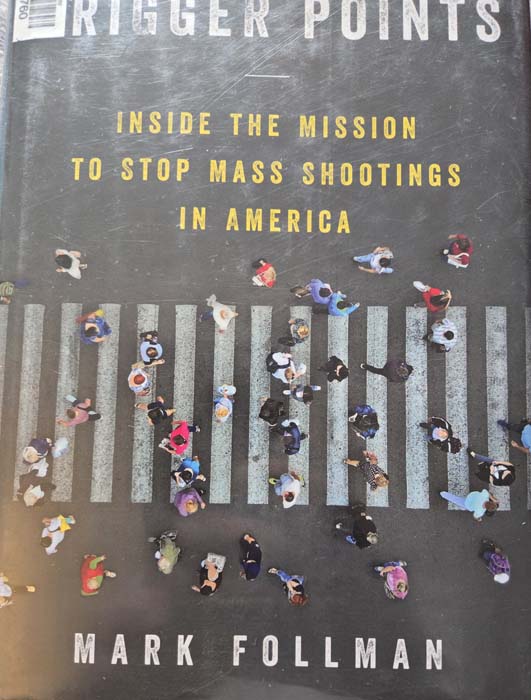COLUMN: Illuminating book about efforts to prevent mass shootings
Published 2:34 pm Tuesday, December 10, 2024

- 20241210_142944.jpg
“Optimism” might seem an improbable word to appear in a lengthy discussion about mass shootings.
But author Mark Follman used the word many times over 239 pages in his 2022 book, “Trigger Points: Inside the Mission to Stop Mass Shootings in America.”
And not because he’s a pollyanna.
Follman, a longtime journalist and national affairs editor for Mother Jones magazine, had investigated mass shootings for more than a decade before writing the book.
In “Trigger Points” he focuses on a topic that, although hardly ignored, seems to me at times overshadowed by the visceral debate about American gun laws.
Follman doesn’t avoid mentioning guns, of course.
No credible author writing at length about mass shootings could fail to acknowledge the relative ease with which people in America can obtain guns — and do so legally, as with many of these crimes.
But Follman, although he endorses more stringent background checks and other legislative attempts to thwart mass shootings, devotes most of his book to examining another possible barrier — identifying potential shooters before they act.
It is the most thorough and thoughtful explanation I have read.
And it’s also the reason that Follman comes across as reasonable in using that word — “optimism” — with regard to a problem that can seem immune to solutions.
Although Follman traveled widely in researching “Trigger Points,” he spent quite a lot of time, and devotes most of chapter 6, to describing an effort in Oregon’s Willamette Valley to identify students who might pose a threat to themselves or to others.
The Salem-Keizer School District’s Mid-Valley Student Threat Assessment Team, formed in response to the shooting at Columbine High School in Colorado in 1999, was a pioneer and remains a model of its kind.
Although individual cases are of course complicated, the basic concept — known as behavioral threat assessment — is elegant in its simplicity.
School counselors, administrators, teachers, students, parents and community members are encouraged to report behavior that is either explicitly threatening or suggests that the person is contemplating violence.
The threat assessment team reviews this information and decides how to respond.
In many cases, Follman writes, intervention by a counselor or teacher, in conjunction with parents, helps students navigate whatever was plaguing them.
Very rarely the student seems to pose a significant danger — by posting a specific threat to a school on social media, for instance, or by trying to get access to guns.
In those cases the team can also get police involved.
Follman writes about a couple of male students in the Salem area whose actions reached that highest level of concern.
In both cases the student not only didn’t hurt himself or others, but both prospered thanks in part to counseling and appropriate medication.
Follman doesn’t underestimate the challenge, however.
He also writes about another Salem student whose case, as Follman described it, was “both triumphant and tragic.”
As a high schooler the student came to the threat assessment team’s attention after he made threatening comments, attempted suicide, went online to try to buy a gun and compiled a “hit list” of potential targets.
But over the next couple years the student did well — in school and out. He graduated in 2002.
Almost seven years later, he went to a dance club in downtown Portland and started shooting a 9 mm pistol he had bought recently. He killed two people and then fatally shot himself.
The episode, Follman writes, “stood as a unique example of both the promise and limitations of behavioral threat assessment.”
Or to put it another way, as Follman does (his italics): “When was a case really over?”
But the vital question that Follman poses, and explores in great detail, isn’t when a case ends but whether one ever begins.
He cites multiple studies, including a 2018 analysis, published by the FBI, of 63 mass shootings at schools, workplaces and other settings.
The key finding, Follman notes, is that in the vast majority of cases the person who committed the crimes had acted in ways, often years before, that could, even without the advantage of hindsight, indicate the person’s potential for violence.
Follman doesn’t oversell this research.
The behaviors that shooters exhibited don’t absolutely predict the future, of course. Most people who act in similar ways never commit mass murder.
But those behaviors, which researchers found had been noticed by friends, classmates, spouses and others, typically happened more than two years before the attack.
Which means, as Follman writes, “the windows of opportunity to intervene continued to exist even if the early warning signs went unnoticed.”
As I read “Trigger Points” I thought several times about a public statement that several Baker County officials, including police and school leaders, as well as district attorney Greg Baxter, signed earlier this year.
The statement emphasizes that police will prosecute people who make threats to schools, including bomb threats.
I agree with that policy.
I also believe that a program similar to the Salem-Keizer School District’s would be beneficial.
Having a team of professionals to assess potential threats could prevent a tragedy.
Moreover, such an effort could help students who, even if they would never commit a crime, could benefit from the attention of caring and conscientious people.





